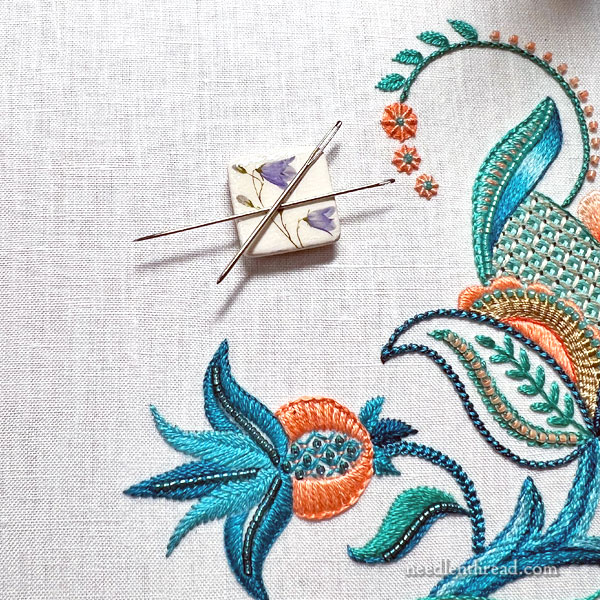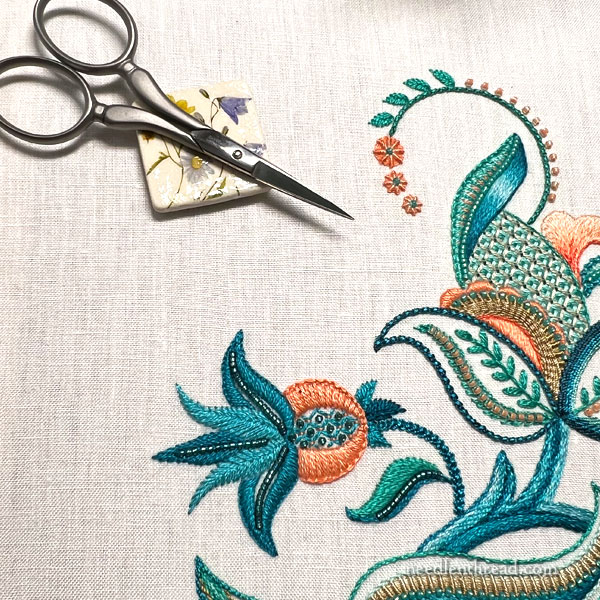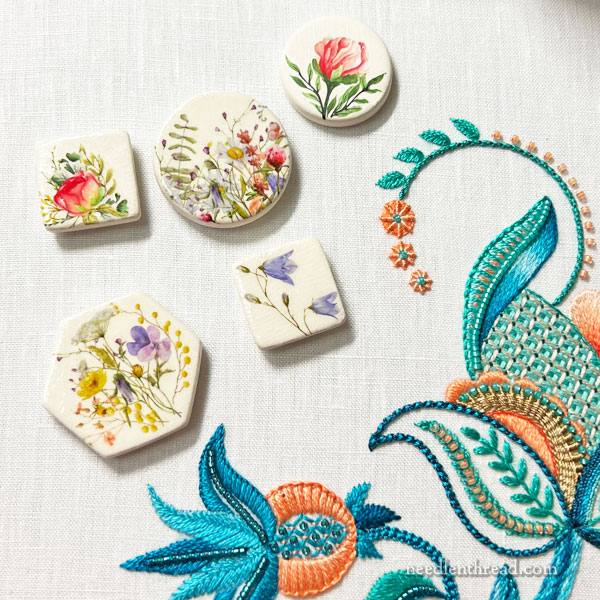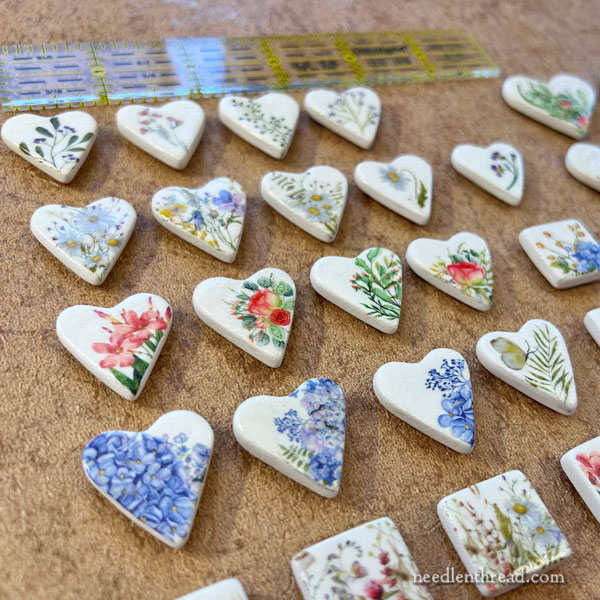I’ve had this article in the works ever since we first launched our collection of hand-crafted bisque needle minders last month. I talked about them at the end of this article. Our first small batch sold out really quickly!
Since then, I’ve had many inquiries from stitchers of every level – from beginners to advanced – who have not used needle minders before. It’s true that they’re not an essential tool for the embroiderer, so no, you don’t need a needle minder to embroider!
Still, I like tools that provide a good service, and I like tools that are pretty. I like the little accessories that go along with needlework, especially when they perform a job and do it with a wee bit of attractive flair!

And while needle minders will probably never be as eminently collectible as scissors (stitchers seem to collect scissors, I’ve noticed), I’ve grown my own little collection of these tools for years. I use them with most projects.
So today, for those who aren’t sure what a needle minder is and what it’s useful for, I thought I’d introduce them to you. For those who already know and already use them, maybe you’ll find some handy tips here.

A needle minder is a magnetic tool that is used to hold needles in a specific place while you’re working on a project. The magnetic strength of the tool can range from very light to rather strong, depending on the minder.
A needle minder comes with two magnets – one is on the back of the decorative part that sits on the front of your fabric, and the other goes behind your fabric, to hold the front part of the minder in place.
Material & Pull
Needle minders come in all kinds of shapes, made from all kinds of materials. Plastic, resin, wood, bisque or porcelain, stone, glass, clay, fabric-covered metal button forms, felted wool, even paper – I’ve seen needle minders made out of practically anything that they could be made out of.
The magnets on the back of needle minders can range from “ceramic” craft magnets and other craft magnets (I generally avoid the kind made with black craft magnets, because they can leave residue on fabric) to stronger neodymium or rare earth magnets.
When creating and testing our needle minders, I leaned towards using magnets with significant pull. I prefer a needle minder that I can be sure will keep my needles where I want them, despite the project getting jostled or bumped.
Over the years, I’ve tested many needle minders that have had such a light pull that they are almost pointless as a needle minder. Bump the frame or hoop, and the needle falls off its perch. What’s the point?
I chose neodymium magnets when making our needle minders for several reasons: 1. They are higher quality than craft magnets; 2. They have a stronger pull, and you can acquire them in a variety of strengths for different purposes; and 3. they come in a wide variety of shapes and thickness.
The Decorative Tops
When it comes to the decorative tops of the needle minder, there are so many styles to choose from! I am always enchanted by beautiful, hand-made minders that consist of three-dimensional scenes, made from polymer clay or from carved wood and the like. As long as there’s enough flat area on the minder to do its job, it’s great to have a lovely work of three-dimensional art that’s fun to look at, on the surface of my fabric while I work.
Unfortunately, some dimensional needle minders just don’t work that great, because the magnet is not strong enough to compensate for the density of the decorative part of the tool. Still, when the magnet is strong enough – when the artist has found that right balance between the beauty and functionality of the piece – these three-dimensional works of art are wonderful!
I’m not a huge fan of rounded or domed decorative tops, though, because this kind of shape encourages the needle to underneath the needle minder in order to cozy up to the magnet.
Choices
When working out a plan for a series of needle minders, I decided to go with flat surfaces, because I think they are more versatile for holding tools. I oscillated between wood or bisque for the body of the needle minder, and finally settled on bisque because it is was more versatile for decorating.
As for magnets, I wanted magnets with enough pull to keep the needles solidly in place.
I also wanted the option of some stronger magnets that work well on frames (like slate frames or stretcher bar frames) that are set up on stands, for larger projects, and that can provide enough pull to hold a small pair of embroidery scissors. I often put my scissors on magnets on the front of my frame when I’m working on larger projects. This gives my scissors a set place to always be so I don’t have to shuffle around for them. And as long as the magnet is strong enough, it keeps them there, even if the frame is jostled.
Now, our needle minders are not so strong that I’d advise carrying a frame around with your good scissors or even your needles stuck on your minders – no, no! That would be risky, anyway. You never want to put your scissors in harm’s way, where they could possibly hit the floor and get damaged. But on a stationary frame, where your work is on-going in one spot, I like a needle minder with enough pull to keep my small scissors in place.

You can use needle minders, then, for more than just holding needles. In fact, the needle minder can fulfill at least three significant functions for the stitcher:
1. Parking Embroidery Needles & Threads
They can hold needles that you’re using during a project. These needles might be pre-threaded so that you don’t have to stop stitching when it’s time to change to a new thread, or they might be already in progress. That is, you’ve “parked” a thread that you were using for a specific color, switched to another color of thread, but intend to switch back to the color that’s “parked” on the minder.
If you’re not familiar with parking embroidery threads, here are two articles that discuss parking embroidery threads, that demonstrate why the process can be very useful in embroidery:
Embroidery Tip: Parking Embroidery Threads
Parking Embroidery Threads (on the Hummingbird Project)
2. Holding Other Small Tools
If you have needle minders with a stronger pull, you can use them to hold small tools, like small embroidery scissors, laying tools, awls, and tweezers.
I wouldn’t pile all those tools on one minder, mind you! But I’d use a minder for each tool, especially if I’m working on a frame that’s on a stand, and my project requires, say, a laying tool. In that case, I have a minder for my scissors, a minder for my laying tool, and a smaller minder (close to the work) for my needles. The larger minders would be set towards the perimeter of the fabric, but I like to keep the needle minder itself close to the work, so I can park working threads – with their needles attached – nearby, ready to go.
3. Holding Charts or Instructions
Needle minders also come in handy for holding charts or instructions on the surface of a frame or large hoop. If I’m working on a large frame and I’m following instructions on a project, I like to use a needle minder to hold the instructions in place on the frame. Sometimes, that’s the same magnet I put my scissors on, and it’s towards the perimeter of the fabric on the frame.

And so, that’s the low down on what needle minders are, how you can use them, and the choices we made for our line of hand crafted minders.
We have a small batch in stock right now, so if you want to take a look, you’ll find them here in the shop. Our plan is to keep them trickling them as we work on them, so they’ll fade in and out of stock, but we’ll do our best to keep the trickle going!







I like needle minders, but do find that they tend to magnetise my needles — and then these have a tendency to want to clump together at all the worst times! 🙂
They do tend to do that. But I’ve grown used to that. I find that magnets are an inevitable part of my set-up in one way or another. For example, I use a telescoping magnet all the time to pick up dropped needles or tools. So I have just decided to embrace the magnification of the needles. LOL!
Great article about minders!
But let’s also talk about the beautiful embroidery that’s in your photos! ❣️
🙂 That’s a project called Jcoban Sea – it’s coming out as a kit one of these days!
I love Needle Minders. First seen them being used by the Flosstube community on You Tube years ago. Do remember if you have a pacemaker you probably should avoid magnets-check with your doctor. I collect them and put them on a large metal sheet made for that purpose. I love having a matching minder such as a Christmas theme for a Christmas project, etc. I turned some pins from the craft store into minders. I love all things stitchy and finally got once of the large DMC chests full of floss. I know I can go to it if I run out of thread and pick up a new skein. My lamp has a metal squared stand that I put some on for my scissors, stitch remover, etc so they’re nearby but not cluttering my project. I bought a lovely handmade band box and the awl item you discussed a while back. You’re an enabler.
Thanks for the explanation. Now I understand why a needle minder would be so useful to me! Of course, now all of yours are sold out, so I took a quick look for others, but yours are so much nicer. I will wait 🙂
what is name of jacobean style piece in this article and what type of threads dis you use?
It’s called Jacobean Sea and it is worked in silk.